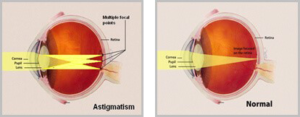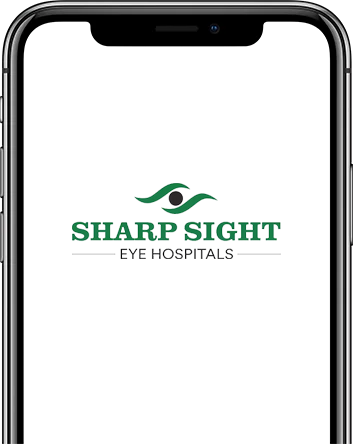Bladeless Cataract Surgery Powered by Sharp Sight Eye Hospitals
- Delivering exceptional outcomes with state-of-the-art technology and skilled ophthalmic surgeons
Bladeless Cataract Surgery
Cataract is an inevitable part of growing old. But, the good news is that it can be treated through hassle-free, bladeless Cataract Surgery.
At Sharp Sight Eye Hospital, we offer reliable and safest cataract surgery through both conventional and advanced laser techniques, which assure excellent visual results.
The surgery barely takes 15 minutes and during the procedure, the cataract-affected lens is removed painlessly and replaced with an artificial lens, called the Intraocular Lens (IOL).
- Top-Notch Eye Care Services
- Learned Eye Specialists
- Advanced & Affordable Treatments
WHAT IS CATARACT SURGERY?
Cataracts are clouding the natural, clear lens of the eye. It usually develops as we age, but occasionally, cataract formation may be seen in newborn babies and young ones too.
These congenital cataracts could be the result of genetic tendencies, drug reaction caused during the developmental stage, eye infection, trauma or injury, etc. However, whatever may be the cause, cataract leads to a double or blurred vision making it difficult for an individual to perform his/her daily chores.
As a caution, you should never let cataract become too severe, as any delay in seeking proper and timely treatment may leave you visually impaired for the rest of your life.
Understandingthe Risk Factors for Cataracts
Identify and understand the key risk factors that contribute to the development of cataracts
Ageing
Due to the age 65 and above
Medicines
Prolonged usage of Steroid Medicines
Exposure
Excessive Exposure to Ultra Violet Rays
Chronic Disease
Presence of diseases like Diabetes
Trauma
Caused due to injury to eye or some trauma
Habits
Habit of drinking alcohol or smoking
Cataract, Types, Surgeries and Technology
Sharpsight Hospitals offers a comprehensive range of advanced surgical options, ensuring the highest standards of care and precision.
- Femto Robotic Cataract
- ZEPTO
- Evolution of Cataract Surgery
- Aberration Free IOLS for Cataract
- Toric IOL for Cataract Astigmatism
- Multifocal IOL for Cataract
Highly Precise & Hassle-Free, Femtosecond Laser-Assisted Cataract Surgery!
At Sharp Sight Eye Hospital, India’s leading chain of best eye hospitals, we have pioneered the Femtosecond Laser-Assisted Cataract Surgery (FLACS) which uses cutting-edge technology for bladeless cataract surgery. Now you can get a 100% bladeless, painless, hassle-free, safest Cataract Surgery through advanced LENSAR technology
Why Choose Femtosecond Laser-Assisted Cataract Surgery?
- It is 100% bladeless.
- The surgical procedure time is much lesser.
- All opening/entry ports are made with the Femto Laser, as the use of mechanical blade has become obsolete.
- Femto Laser technology treats even the most complicated cases with high precision.
- Incisions are computer programmed, thereby leaving no margin for error.
- It does not cause any damage to the cornea.
- It offers fast recovery and reduces post-operative astigmatism.
- Better outcomes can be seen with MFIOL, Toric, and other premium IOLS with Femtosecond Laser Technology.
At Sharp Sight Eye Hospital, we take pride in being one of the very few eye hospitals in the country to acquire US- FDA-approved LENSAR technology with spectacular clinical outcomes.
Zepto is the latest addition to our armamentarium of state of art technology. It ensure a perfect capsulorrhexis (Key hole in anterior capsule of lens) in the most difficult cases thus enabling accurate IOL placement.
What are the advantages of zepto technology?
- Robotic precision
- Predictable results
- Reduced surgical time
- Enhanced vision
- Suitable even in complicated cases, such as pediatric cataract, cases with small pupil, etc.
Zepto is the latest addition to our armamentarium of state of art technology. It ensure a perfect capsulorrhexis (Key hole in anterior capsule of lens) in the most difficult cases thus enabling accurate IOL placement.
Advantages of Mics Cataract Surgery
- Faster vision recovery due to small incisions.
- No change in the original shape of the eye. Thus, fewer chances of astigmatism and thus lesser requirement of post-operative spectacles.
- Enhanced vision with improved IOLs
- Faster healing even in diabetic patients.
- Minimal postoperative restrictions.
- Fewer follow-up visits post-surgery.
- Patients can resume daily activities like watching TV, computer, reading, etc., immediately.
Traditional Intraocular Cataract Lenses or IOLs, have been spherically aberrated, which means their front and back surfaces are uniformly curved. Hence all the light rays are focused at varying points forming slightly blurred images. Intra Ocular lenses have evolved with time to give better clarity at varying distances and lighting conditions.
Aspheric IOLs, are slightly flat in the periphery and are designed to provide better contrast sensitivity and better vision in low light conditions. They achieve this by focusing all the light rays at one common point and forming a crisp aberration-free image.
These lenses give a better visual perception even in low light conditions and are theoretically known to give a better color resolution to the implanted eye. In addition, they are also known to offer many other advantages apart from the ones mentioned above.
What is Astigmatism?
While a normal eye would have a smooth, round cornea and lens, people with astigmatism have an irregularity in their cornea or lens in a particular axis. Astigmatism is a common refractive error that causes blurred vision without the use of glasses or contact lenses.

When undergoing cataract surgery, astigmatism less than ID can be corrected using unique incisions but astigmatism more than ID will need implantation of a special IOL which has the correction added in that axis.
What are the Benefits of Toric IOLS?
- This single-piece foldable lens is flexible and comfortable for the human eye.
- Toric lens implantation for cataract surgery has shown positive reviews in terms of both optical performance and higher quality vision.
- It reduces dependency on distance glasses.
At Sharp Sight Eye Hospital, India’s leading chain of best eye hospitals, we have
- Refractive Multifocal Lens:
These lenses are an excellent choice for intermediate and distance vision. Near vision is acceptable except for fine print, such as grocery labels or medicine labels, etc. However, patients usually resort to this problem by keeping a pair of near vision spectacles handy. With Refractive Multifocal IOL, patients may experience glare and haloes around lights at night but using night driving spectacles helps them to get rid of the problem.
- Diffractive Multifocal Lens:
When it comes to providing both reading and distance vision, these implants are an excellent choice. The intermediate vision is acceptable but for long duration of computer work, where glasses come handy. Patients experience lesser glares & haloes around lights at night. However, many patients get accustomed to this drawback or as an alternative they use night driving spectacles, to combat this.
When to avoid multifocal IOL
IOL is not suitable for cataract patients with:
- Severe retinal problems like Retinal Detachment, Macular Degeneration, Macular Holes, Diabetic Retinopathy, etc.
- The surgical procedure time is much lesser.
- Advanced Glaucoma.
- Cornea problems such as Keratoconus, irregular Corneal Astigmatism, etc.
- Patients who have undergone procedures such as LASIK, PRK etc.
Why Sharpsight forCataract Surgeries?

Frequently Asked Questions
What is cataract and how does it affect our vision?
Cataract is clouding of the natural lens of the eye and it is an inevitable part of ageing. And, when the light passes through the cataract or cloudy lens, it gets blocked or distorted which leads to the formation of a blurred image on the retina. As a result, cataract development causes impaired night vision, affects color sharpness and gradually makes it difficult for an individual to perform his/her daily chores.
What are the common causes of cataract?
What are common signs of cataract to watch out for?
- Blurred, cloudy or
- distorted vision
- Poor night vision
- Light sensitivity
- Trouble reading/watching TV
- Glare/halos
- Double vision
- Color distortion
If you experience any of the above symptoms, it’s time you get your eyes examined by a cataract specialist.
How is cataract treated?
Is there any best time for cataract surgery?
Is it possible for a diabetic to undergo cataract surgery?
How is cataract surgery performed and is it a painful procedure?
Can all patients having a cataract undergo microincision phaco surgery?
What are the various types of intraocular lenses (IOLs) available these days?
- Monofocal IOL: These lenses provide good distance vision and most patients are not dependent on their distance glasses for daily activities. However, patients implanted with Monofocal IOLs require reading glasses after cataract surgery. Lately, Monofocal lenses have improved image quality by enhancing contrast, eliminating glare, and improving night vision.
- Toric IOL: These lenses correct high cylindrical power by reducing the patient’s dependence on distance glasses.
- Multifocal IOL and Accomodating IOL: These lenses are designed to provide distance and near vision with less dependence on glasses.
At Sharp Sight, we have a range of best cataract lenses in India. Our experts help you choose an IOL that highly suits your daily needs.
What is the life of an intraocular lens and how safe are these?
Can cataract be treated with lasers and what is femtosecond bladeless cataract surgery?
Is femtosecond bladeless cataract surgery different from traditional cataract surgery?
What are the advantages of femtosecond laser assisted cataract surgery?
Apart from getting rid of cataract, are there any other benefits of a cataract surgery?
Cataract surgery has many benefits like vision becomes sharp and crystal clear, one can almost immediately resume doing activities such as driving, reading and watching TV, etc. In short, post-cataract surgery, a patient can lead a life without being totally dependent on glasses.
We've a strong portfolio of Happy Patients
We have served more than a million patients and have helped them see this world clear.



